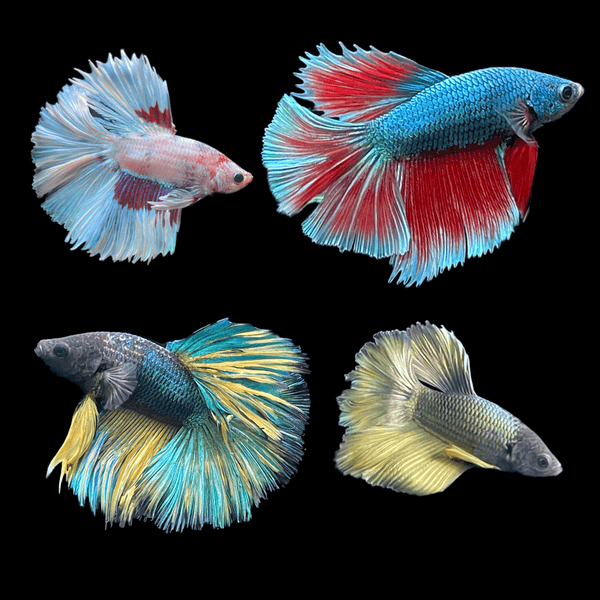Betta Fish Lifespan: Just How to Ensure Your Betta Lives Longer
Betta Fish Lifespan: Just How to Ensure Your Betta Lives Longer
Blog Article
Just How to Reproduce Betta Fish Effectively: Expert Techniques and Insights for Hobbyists Aiming To Increase Their Betta Collection
Reproducing Betta fish requires a nuanced understanding of genes and environmental problems, making it crucial for hobbyists to come close to the process with both persistance and treatment. Creating an optimal breeding environment, selecting the best pairs, and observing the complexities of their courtship habits are fundamental steps that can substantially impact the result.
Comprehending Betta Fish Genetics
Comprehending the genes of Betta fish is important for effective breeding, as it influences attributes such as shade, fin form, and habits. Betta fish exhibit a varied range of shades and patterns, greatly determined by their hereditary make-up. The main genetics responsible for coloration consist of the "B" gene for blue, "D" gene for red, and the "C" genetics for color strength. Breeders can manipulate these qualities by choosing particular parent fish that show preferred features.
Along with coloration, fin morphology is another considerable facet of Betta genetics (betta fish). The sizes and shape of fins are influenced by various genes, consisting of those that identify whether the fins are short, long, or veil-shaped. Comprehending these hereditary variations assists breeders anticipate the phenotypic results of their spawn
Moreover, behavior traits such as aggressiveness and territoriality can also be influenced by genetics. These behaviors play a crucial function in the reproducing process, as they can affect generating success and the total character of the resulting fry. By comprehensively recognizing these hereditary concepts, dog breeders can make educated decisions, ultimately enhancing their breeding programs and attaining desirable results.
Preparing the Breeding Atmosphere
Developing an optimum breeding environment is vital for the successful reproduction of Betta fish. The first action in preparing this setting is to pick an ideal breeding container, ideally ranging from 5 to 10 gallons.
Following, take into consideration making use of a sponge filter or an air rock to provide gentle water circulation without creating solid currents that can worry the fish. It is necessary to mount plants or breeding cones to offer hiding areas and promote convenience for the female during the spawning procedure. Drifting plants, such as Java moss or water sprite, can likewise create a more native environment while assisting in bubble nest building by the male.
Prior to introducing the reproducing pairs, make sure the water is conditioned and complimentary from hazardous chemicals, such as chlorine or heavy metals. betta fish. Regular water changes should be conducted to preserve ideal Discover More water quality, boosting the opportunities of successful reproduction. With these preparations in place, the breeding environment will certainly support the health and health of both Betta fish
Selecting Reproduction Pairs
Choosing the right breeding pairs is vital for achieving successful Betta fish reproduction. Healthy and balanced Betta fish display vibrant shades, clear eyes, and energetic behavior.
Personality is an additional crucial factor to consider, as Betta fish are recognized for their aggressive nature. It is suggested to select a male and woman that show suitable temperaments to decrease stress during the reproducing procedure. A tranquil man can encourage a smoother courtship, while a female that is also hostile might disrupt the procedure.
Genetic background likewise plays a considerable function in the high quality of the children. Reproducing fish that are genetically diverse can lower the threat of hereditary health and wellness problems and improve the overall vitality of the fry. It is advantageous to investigate the family tree of both the male and lady, focusing on desirable qualities such as fin kind, color scheme, and dimension.
The Breeding Process
The breeding procedure of Betta fish requires cautious preparation and focus to detail to guarantee a successful end result. At check this site out first, it is essential to prepare an appropriate reproduction container, preferably a 5-10 gallon aquarium with a temperature level maintained at 78-80 ° F. The tank needs to be outfitted with a heater, filter (ideally sponge kind to avoid strong currents), and lots of marine plants for the lady to hide.
When the atmosphere is set, introduce the picked reproducing pair to the tank, allowing them to adapt. Observe their habits; the male will present fancy courtship routines, consisting of flaring his fins and constructing a bubble nest. If the lady reveals passion, she will certainly present upright red stripes suggesting preparedness for spawning.
When the lady is responsive, the set will certainly engage in a breeding embrace, during which the male feeds the eggs. Preserving ideal water problems throughout this duration is important for the growth of healthy and balanced Betta fry.
Taking Care Of Betta Fry

Feeding Betta fry is essential, as they require a diet regimen high in healthy protein. Initially, they can be fed infusoria or fluid fry food, transitioning to carefully crushed high-grade pellets as they grow. Feed little portions numerous times a day to motivate healthy growth without overwhelming the tank with leftover food.

As they develop, monitor their development carefully and separate any type of hostile people to avoid damage. By giving a supporting atmosphere and correct nutrition, enthusiasts can efficiently increase Betta fry into lively, healthy fish, inevitably boosting their breeding ventures.
Conclusion
Successful Betta fish breeding requires precise interest to hereditary choice, ecological problems, and care for the fry. By understanding the genes of Betta fish and preparing a proper reproduction environment, hobbyists can improve the opportunities of producing vivid, healthy and balanced spawn.
Report this page